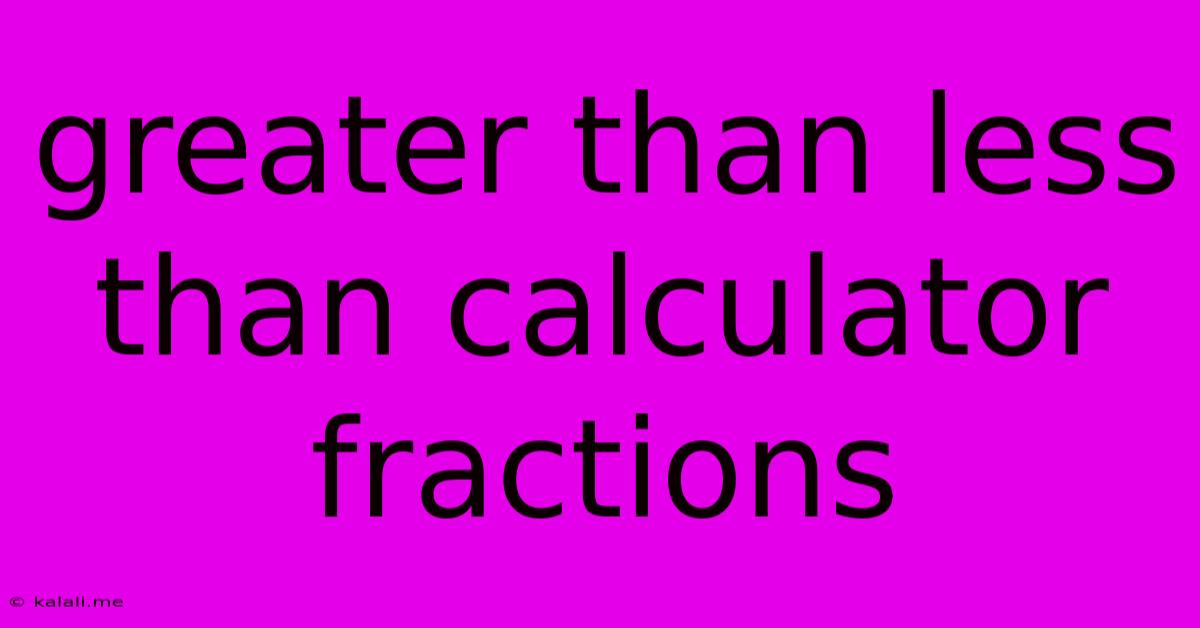Greater Than Less Than Calculator Fractions
Kalali
Jun 13, 2025 · 3 min read

Table of Contents
Greater Than, Less Than Calculator for Fractions: A Comprehensive Guide
Are you struggling with comparing fractions? Figuring out whether one fraction is greater than, less than, or equal to another can be tricky, especially with complex fractions. This article will guide you through the process of comparing fractions, explaining the underlying concepts and showing you how to use a greater than, less than calculator for fractions effectively. We'll also cover alternative methods to help you confidently tackle fraction comparisons.
What is a Greater Than, Less Than Calculator for Fractions?
A greater than, less than calculator for fractions is a tool that simplifies the comparison of two or more fractions. You input the fractions, and the calculator instantly determines which fraction is larger, smaller, or if they are equal. This saves you the time and effort of manual calculation, particularly helpful when dealing with complicated fractions or when speed is essential. While such calculators are readily available online, understanding the underlying math is crucial for deeper comprehension and problem-solving skills.
Understanding Fraction Comparison: The Basics
Before we delve into using a calculator, let's review the fundamentals of comparing fractions. There are several methods:
-
Finding a Common Denominator: This is the most common method. To compare two fractions, find the least common multiple (LCM) of their denominators. Convert both fractions to equivalent fractions with the common denominator. Then, compare the numerators: the fraction with the larger numerator is the greater fraction.
Example: Comparing 2/3 and 3/4. The LCM of 3 and 4 is 12. 2/3 becomes 8/12, and 3/4 becomes 9/12. Since 9 > 8, 3/4 > 2/3.
-
Converting to Decimals: Another approach involves converting both fractions to decimals. This is easily done by dividing the numerator by the denominator. Then simply compare the decimal values.
Example: Comparing 2/3 and 3/4. 2/3 ≈ 0.667 and 3/4 = 0.75. Since 0.75 > 0.667, 3/4 > 2/3.
-
Cross-Multiplication: This method is a shortcut for finding a common denominator without explicitly calculating it. Cross-multiply the numerators and denominators of the two fractions. The fraction whose product is larger is the greater fraction.
Example: Comparing 2/3 and 3/4. (2 * 4) = 8 and (3 * 3) = 9. Since 9 > 8, 3/4 > 2/3.
Using a Greater Than, Less Than Calculator for Fractions: A Step-by-Step Guide
While the methods above are essential for understanding, using a calculator streamlines the process:
- Find a reliable online calculator: Search for "fraction comparison calculator" or "greater than less than fraction calculator." Many free calculators are available.
- Input the fractions: Enter the fractions you want to compare into the designated fields of the calculator, ensuring you input them correctly (numerator/denominator).
- Review the results: The calculator will display the result, indicating which fraction is greater than, less than, or equal to the other.
Beyond Basic Comparison: Handling Mixed Numbers and Improper Fractions
Most calculators can handle mixed numbers (e.g., 1 1/2) and improper fractions (where the numerator is larger than the denominator, e.g., 5/4). However, it's crucial to input them correctly according to the calculator's instructions. Often, you'll need to convert mixed numbers into improper fractions before inputting them.
Troubleshooting and Tips
- Double-check your input: Errors in input are common. Carefully review the fractions you've entered before submitting them.
- Explore different calculators: If one calculator doesn't work as expected, try a different one. Calculators may have slightly different input methods.
- Understand the limitations: While calculators are helpful, understanding the underlying mathematical principles is crucial for complex problems and independent problem-solving.
By understanding the core principles of fraction comparison and utilizing online tools strategically, you can confidently compare fractions of any complexity, saving time and improving your mathematical skills. Remember that a calculator is a tool; mastering the underlying concepts will make you a stronger mathematician.
Latest Posts
Latest Posts
-
Which Of The Following Is An Example Of Reduction
Jun 14, 2025
-
Difference Between Small Scale And Large Scale
Jun 14, 2025
-
1 Hp Is Equal To How Many Watts
Jun 14, 2025
-
All Of The Following Are Primary Air Pollutants Except
Jun 14, 2025
-
Why Do People Go To Weekly Market
Jun 14, 2025
Related Post
Thank you for visiting our website which covers about Greater Than Less Than Calculator Fractions . We hope the information provided has been useful to you. Feel free to contact us if you have any questions or need further assistance. See you next time and don't miss to bookmark.